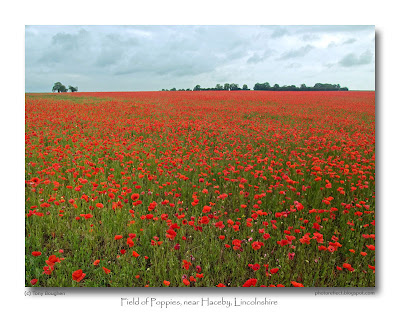 click photo to enlarge
click photo to enlargeIt has been my misfortune, in recent years, to come upon fields of poppies only when I've been travelling somewhere by road. And, when you pass a scarlet field that smacks you in the eye like these fields do, you've just got to stop and get snapping. Consequently I've had to park, get out, secure the best shot I could manage in a short time with whatever light is available, and then carry on my way. So it was a couple of days ago when I was heading west along the main road near Haceby, Lincolnshire. And so it was last year too, when travelling to Stamford.
That Stamford image shows poppies in a field of oilseed rape. Prior to that particular photograph I've been used to snapping these beautiful red flowers when they appear in cereal fields - usually wheat or barley. And, because they are interlopers that the farmer has usually tried to eradicate in one way or another, the poppies that I come across are scattered in various densities around field margins or throughout the crops. So, when I strode into this field, where the density was much more uniform, making the field appear an almost unbroken blanket of red, I was interested to see which commercial crop they'd invaded and virtually taken over. To my surprise the field was entirely poppies interspersed with a few wild flowers. Anxious to learn why farmers are planting poppies (which clearly weren't the opium variety!) I came upon a news article that might hold the answer. Apparently some farmers are letting the poppy seeds that have been suppressed for decades by chemicals spring up and come into flower in selected fields where they want to increase nitrate levels in the soil. It seems that a red field full of beautiful, naturally occurring poppies, like this one, can be a step on the way to the production of wheat by organic methods. All I can say is I hope to see more farmers following this system, not only for the benefits that organic farming confers on the land and wildlife, but because of the spectacular colour that it introduces into the countryside.
photograph & text (c) T. Boughen
Camera: Olympus E510
Mode: Aperture Priority
Focal Length: 12mm (24mm/35mm equiv.)
F No: f7.1
Shutter Speed: 1/200 seconds
ISO: 100
Exposure Compensation: -1.0 EV
Image Stabilisation: On